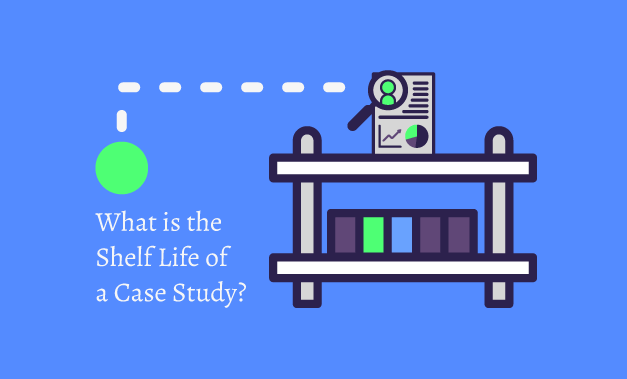The shelf life of a Case Study typically lasts as long as your business does. In fact, its timeless quality is part of a Case Study’s appeal. However, there are occasions when a Case Study needs to be rewritten, if not retired and replaced altogether. This article explores those instances.
The Shelf Life of a Case Study
By and large, Case Studies have long shelf lives. They showcase the best parts of your business and why your customers love working with you. Sales and marketing teams incorporate them into their workflows, and the best teams come to know the Case Studies’ content so well they may have even memorized them.
But circumstances change, and there are some instances in which a Case Study is no longer appropriate to use in its current state.
When to Replace or Update Your Case Studies
If any of the following information has changed, then your Case Study’s shelf life may be at its end:
Your Company’s Name and/or Branding
A high-quality Case Study is a professional way to describe what your company can do for customers and quickly communicate your brand. Giving a sales prospect access to a Case Study that doesn’t have your most current name or brand guidelines diminishes that professionalism.
Simply put, it’s not a good look to have your client-facing documentation not looking its best. If your company can’t be bothered to have the right name and branding on documents meant to persuade people to become customers, do you really think you can convincingly assure prospects you can solve their problems? Don’t expect prospects to just understand that you haven’t updated your B2B content with the right information yet. Having the correct name and branding on your Case Studies is the bare minimum.
Your Company’s Offering
All your Case Studies should reflect your current product or service offerings. If your Case Study describes how transformative Product X has been for your client, but your company doesn’t offer Product X anymore, the Case Study is not doing you any favors. You won’t win prospects with a story about a product that doesn’t exist. You’ll need to rework the narrative to make it still applicable, but it may be easier to just replace it altogether.
Your Company’s Goals
Your Case Studies should not only showcase your best attributes—they should also align with the direction in which you want your company to head. Say you’ve decided that want your company’s name to be synonymous with innovative technologies. However, all your current Case Studies underscore your fantastic customer service and timely implementations. There’s nothing wrong with that, but you’re not impressing your revolutionary tech solutions on prospects that way. You need new Case Studies that support your goals.
Your Client’s Name, Branding, Location, and/or Offerings
If the client has changed its name and/or logo, you should update the Case Study with the appropriate information and imagery. If the client relocated, you may need to edit the text accordingly. You’ll also want to take into consideration any client-related images that are in the Case Study—do they still accurately show where the company is and what it does?
Your Client’s Business Status
Completely retiring the Case Study may be in order if the client has gone out of business. Prospects want to hear how your clients thrived thanks to your company. Even if a company shutters its doors for reasons that have nothing to do with you, you don’t need prospects wondering, “Why are they telling me a story about a business that—despite it all—failed?”
A Poor Client Relationship
Another reason to stop using a Case Study altogether is if your company no longer has a positive relationship with the featured client. It’s one thing if the client simply no longer relies on your products or services anymore. But if the situation with a client has gone so south that you would never ask or hope for that client’s recommendation today, it’s time to retire the Case Study in question.
A Poor Client Reputation
Another good reason to remove a Case Study from rotation is if the client’s reputation is not in good standing. You don’t want to try to drum up new business using a Case Study featuring a client or Case Study Subject that’s steeped in controversy. Prospects won’t care if you helped Client A save thousands of dollars if Client A is associated with strong negative public feelings and opinions. This is especially true if the problems with Client A are in opposition to your company’s goals and values. Even if you helped Client A long before the trouble began, it’s best to anonymize the Case Study or scrap it completely.
Prolonging the Shelf Life of Your Case Study
You have options when it comes to deciding what to do about your outdated Case Studies. However, the best solution will depend on why they need to be updated or retired in the first place and how extensive the necessary changes are.
One thing is certain: Always ensure your company’s name and branding are correct on your Case Studies. Fortunately, updating these is the simplest change to make since the rest of the content will stay the same.
Beyond that, deciding the fate of a Case Study becomes murkier. Any potential updates depend on the Case Study itself. For example, maybe it makes sense to keep the client’s location the same, even if it’s since changed. Or maybe there’s a reason you want to use a Case Study touting the quality of a product you no longer offer. Context is everything. Situations like this may just require some small updates to the text.
However, strong reasons to decommission a Case Study include a client’s poor reputation or a soured relationship between you and the client. Keeping the Case Study around in those instances just isn’t worth the hassle. Either anonymize it, or better yet, start fresh with a Case Study about a new client!
Conclusion
Case Studies are meant to last. But life happens, and some events may necessitate some housekeeping when it comes to your Case Study library. Sometimes the change is as small as changing, removing, or adding a single word. For other occasions, you may need to anonymize the document, if not retire it completely. When determining what to do, opt for the decision that makes the most sense for your business’s goals.
We at SuccessKit can help you rework or update your existing Case Studies or create new ones from scratch. Learn more by contacting us at [email protected].




























































